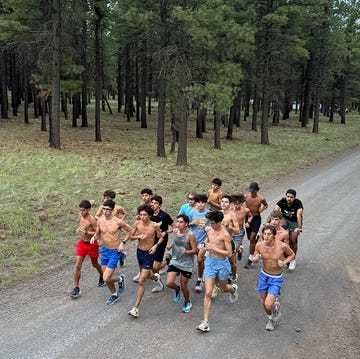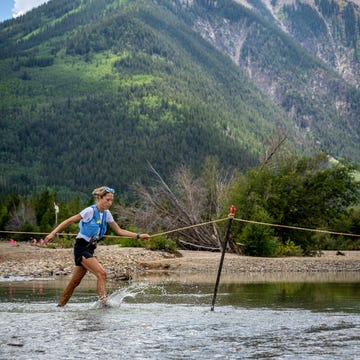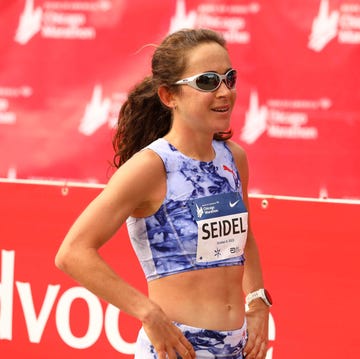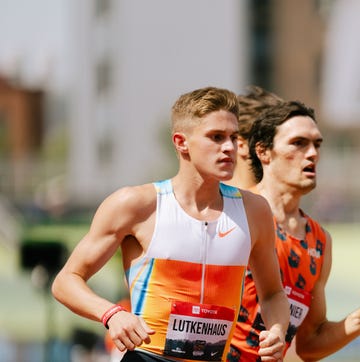In most cases, last week’s U.S. Olympic Track and Field Trials served their purpose of selecting the team that will compete in August at the Paris Olympics. But as Runner’s World warned beforehand, there are a few situations that still aren’t definitive.
Women’s 10,000 Meters
We’ll start with the trickiest situation: the women’s 10,000 meters. Going into the meet, only Weini Kelati had achieved the automatic Olympic qualifying standard of 30:40. She won the Trials in 31:41.07, securing her spot in Paris—straightforward enough.
But second-place finisher Parker Valby and third-place finisher Karissa Schweizer didn’t have the standard beforehand. They both finished in 31:41.56—a fraction of a second apart, and not fast enough to obtain the standard in that race.
Recall, though, that World Athletics also grants Olympic qualifiers to athletes with a high enough score in its world rankings. Each athlete is assigned a performance score for each qualifying race based on their finishing time and place during the eligibility period (which, for the 10,000 meters, ran from December 31, 2022, to June 30). Then, their top scores are averaged together to calculate their ranking score.
Before the race, only Katie Izzo was high enough in the world rankings to qualify, by virtue of her placement in cross-country races in November and December. She finished 13th at the Trials, in 32:30.31.
As Runner’s World predicted, when the updated rankings were published on July 1, the results of the Trials boosted Valby’s ranking score to 1,213, and Schweizer’s to 1,209. That moves them up in the list—but not enough, right now, to fall within the rankings quota (as of right now, the last athlete who qualifies for the 27-woman field based on rankings has 1,236 points).
And in fact, two American athletes who competed in the race—Elly Henes, who placed ninth in 32:25.17, and Natosha Rogers, who placed 12th in 32:28.70—still have more points than Valby and Schweizer do (1,227 for Henes and 1,215 for Rogers).
The qualifying period is now closed, meaning no athlete can post a performance that nets them a higher score. So how could positions change now? Well, between June 30 and July 7, each country—including USATF—submits the list of athletes they’d like to send to the Games, provided they’re eligible to compete.
Other countries might decline some of their allotted spots because qualified athletes are injured or otherwise aren’t available or selected to compete. If enough international athletes scratch, that would shuffle everyone up on the list, and potentially shift Valby, Schweizer, or both into a position that qualifies them based on rankings.
And that’s what USATF wants—for the top three Trials finishers to compete at the Games. But they also don’t want to send fewer than three athletes if they have three who are eligible and who competed at the Trials.
So what’s likely to happen is that USATF sends World Athletics a list of all the Trials finishers who could potentially qualify—from Kelati in first place to Izzo in 13th.
When World Athletics posts the finalized rankings on July 7, USATF will see which American athletes are eligible based on how the rankings shake out. They’ll award the two remaining spots to qualifying athletes, based on their finishing order at the Trials.
For instance, if Valby and Schweizer both move up enough to qualify by ranking, the spots will be theirs. If only Valby does, but not Schweizer, the spots could go to Valby and Henes. And if Henes does, but not Valby and Schweizer, the spots could go to Henes and Izzo. They—and we—will have to wait until July 7 to know for sure.
Schweizer already has a spot on Team USA this summer, because she placed third in the 5,000 meters and had the qualifying time. But she’ll gladly double if she has the opportunity, her agent Tom Ratcliffe told Runner’s World on July 2. As for Valby, well, that leads us to the next race that isn’t yet set in stone.
The women’s 5,000 meters
The 10,000 meters has implications for the 5,000 meters.
On June 24, Elle St. Pierre won the 5,000 meters at the Trials in 14:40.34, by 0.02 seconds over Elise Cranny. Schweizer was third in 14:45.12, and Valby was fourth in 14:51.44. All four have the Olympic standard. Whittni Morgan in fifth did not have the standard, but her world ranking is high enough to allow her to run at the Games.
St. Pierre said immediately upon finishing third in the 1500 meters on June 30 that she would forgo her Olympic spot in the 5,000 and focus solely on the 1500 meters in Paris. So that would mean Cranny, Schweizer, and Valby would be the Olympic team. But if Valby gets into the 10,000 meters, would she opt to run both the 5,000 and 10,000 or would she run only the 10,000 or only the 5,000? (Morgan would sure like to know Valby’s plans.)
Valby’s coach, Will Palmer, said on July 2 that they were “optimistic” Valby would get into the 10,000, but they didn’t have any final confirmation. When asked about doubling, the response from Palmer was: “Haven’t made any decisions.”
The first round of the women’s 5,000 meters in Paris is on August 2—less than a month away.
Men’s 5,000 meters
On the final day of the Trials, Grant Fisher won the men’s 5,000 meters (13:08.85), in addition to his earlier victory in the 10,000, and he said he would run both events in Paris. Abdihamid Nur (13:09.01) was second. Both already had the Olympic standard from earlier races.
Parker Wolfe, who just finished his junior year at the University of North Carolina, was third in a personal best of 13:10.75. But he missed hitting the Olympic qualifying standard (13:05.00). His ranking is currently 45th, just outside of the top 42 needed to be in the field. Will there be enough scratches above him so that he could go?
If not, Graham Blanks, a rising senior at Harvard, would go to Paris. He ran 13:03 last December indoors, bettering the Olympic standard.

Cindy is a freelance health and fitness writer, author, and podcaster who’s contributed regularly to Runner’s World since 2013. She’s the coauthor of both Breakthrough Women’s Running: Dream Big and Train Smart and Rebound: Train Your Mind to Bounce Back Stronger from Sports Injuries, a book about the psychology of sports injury from Bloomsbury Sport. Cindy specializes in covering injury prevention and recovery, everyday athletes accomplishing extraordinary things, and the active community in her beloved Chicago, where winter forges deep bonds between those brave enough to train through it.

Sarah Lorge Butler is a writer and editor living in Eugene, Oregon, and her stories about the sport, its trends, and fascinating individuals have appeared in Runner’s World since 2005. She is the author of two popular fitness books, Run Your Butt Off! and Walk Your Butt Off!














